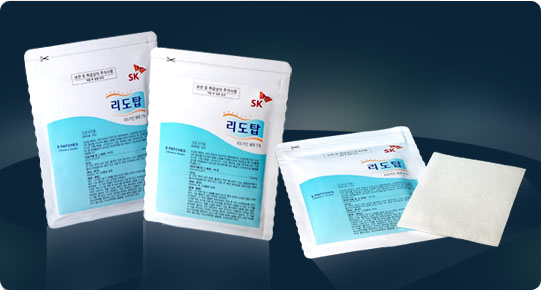SK chemicals Site ManagerWorld’s first drug patch for neuralgia caused by herpes zoster
The US FDA approves the drug after acknowledging its highly beneficial treatment and mild side effects.
The American Academy of Neurology and other bodies select it as the no. 1 painkiller for neuralgia following treatment for herpes zoster.

SK chemicals (Vice Chairman and CEO Kim Chang-geun) announced on June 1 that it has released the world’s first anti-neuralgia Lidotop patch for people who have suffered from herpes zoster. Lidotop became Korea’s first topical analgesic patch for easing post-herpes zoster neuralgia to receive approval from the FDA.
Lidotop, which was introduced by SK chemicals via Teikoku Pharma USA/ San Jose (CEO: Masahisa Kitagawa) in 2005, is the world’s first Lidocaine patch for application to a painful area, quickly easing pain without causing any of the side effects known to occur with existing oral compounds.
According to a report from the Association of Korean Dermatologists, the neuralgia that follows herpes zoster continues after the rashes caused by the disease have been treated. This pain may disappear within several months, although for some patients it may continue for several years or even for life.
Specialists agree that “Even after treatment for the disease, patients suffering from herpes zoster can feel severe pain from a small stimulus which has no effect on ordinary people, and can develop depression, insomnia, and loss of appetite. As such, we keenly need the appropriate drugs.”
The Lidotop patch caters well to this need. The soft, flexible patch covers the parts of the body where the patients feel pain, providing a physical barrier to the skin and reducing pain from physical stimuli.
Existing oral drugs cause diverse and serious side effects, requiring an adjustment of their usage volume, while the Lidotop patch showed no side effects during its 2-phase and 3-phase clinical tests.
Recognizing the beneficial effect and safety of Lidotop, the American Academy of Neurology, the International Association for the Study of Pain, and other major overseas academies recommend Lidotop as an effective drug for treating pain following treatment for herpes zoster (AAA’s journal Neurology, 2004).
The size of the US market for the Lidocaine patch was estimated at 660 billion won last year, while the domestic market for neuralgia following the treatment of herpes zoster is estimated at 20 billion won. SK chemicals is set to generate 10 billion won within three years from the sale of Lidotop.
Upon the release of the drug, Shin Seung-kwon, the CEO of SK chemicals’ Life Science Division, said, “Previously, patients suffering from neuralgia following treatment for herpes zoster took anti-depressants and anti-convulsants without effective drugs, suffering a double dose of pain due to the side effects. With our safe, quick and highly effective Lidotop patch, we will cure patients of herpes zoster completely.”
SK chemicals, which has striven to treat patients suffering from pain caused by arthritis of the knee with its Trast patch, is poised to develop drugs for other pains, in addition to the Lidotop patch.
*For reference
- Patch
Patches are designed to contain medication and are adhered to the painful areas, allowing the effect of the medication to be released into the appropriate part of the body over a certain period of time.
- Teikoku Pharma USA
Established in San Jose, USA, in 1997, Teikoku Pharma USA is a subsidiary of the Japanese company Teikoku Seiyaku, which specializes in trans-dermal delivery systems (TDDS).
- Herpes Zoster
Herpes zoster is a viral disease that causes the patient to develop small band-like blisters over a certain area of the body. The patient suffers severe pain, abnormal sensations in a part of the body or the face, and hot and piercing pains.
The virus originates with the varicella-zoster virus which causes varicella; when a person suffers from varicella during childhood, the virus remains in his or her body, and is reactivated when the person is old or when his or her immunity is weakened, thereby causing the disease. If early treatment time is lost, long-term complications such as aggravated symptoms and post-herpetic neuralgia (PHN) can develop.